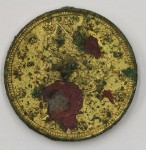 Coin experts have identified a rare example of an 1883 Racketeer Nickel in a group of coins excavated in the historic Chinatown of Deadwood, South Dakota. The coin was discovered in July of 2001 during one of four excavations of Deadwood’s Chinatown district. It was one of more than 200 coins found over the course of four years, most of them Chinese brass pieces. They were all sent to the South Dakota Archeological Research Center in Rapid City to be catalogued only to return to Deadwood in 2009 when City Hall got a new storage facility and laboratory for historic artifacts.
Coin experts have identified a rare example of an 1883 Racketeer Nickel in a group of coins excavated in the historic Chinatown of Deadwood, South Dakota. The coin was discovered in July of 2001 during one of four excavations of Deadwood’s Chinatown district. It was one of more than 200 coins found over the course of four years, most of them Chinese brass pieces. They were all sent to the South Dakota Archeological Research Center in Rapid City to be catalogued only to return to Deadwood in 2009 when City Hall got a new storage facility and laboratory for historic artifacts.
Nobody realized there was a very special coin in the mix until this year. Deadwood Historic Preservation Office had sent photos of the Chinese coins to numismatists Dr. Margie Akin and her husband Kevin Akin last year. They were able to identify all but 16 of them from the pictures. In September of this year, the Akins went to Deadwood where they were asked to examine the 16 mystery coins in person. That done, City Archivist Mike Runge, who is in charge of the city’s vast college of documentary and archaeological materials, showed them a small group of US coins that had been found during the digs.
“It’s a common joke among archeologists that the best thing you find, the most important discoveries, are made in the last hour of the last day,” Margie Akin said recently from California. “I’ve seen many cases where that has been true.”
And it came true again. […]
“When we found it, I held it up and said, ‘Margie, look at this. A Racketeer Nickel, oh my God!'” Kevin recalled. “It was a bit of a Eureka moment.”
 What makes the 1883 Racketeer Nickel such a treasure is that it looked a lot more expensive than it was. It was close in size to a $5 gold piece, and it was the first base metal coin to have a Liberty-head design. The Mint also muddied the waters by only indicating the coin’s value with the Roman numeral “V.” The word “cents” appeared nowhere.
What makes the 1883 Racketeer Nickel such a treasure is that it looked a lot more expensive than it was. It was close in size to a $5 gold piece, and it was the first base metal coin to have a Liberty-head design. The Mint also muddied the waters by only indicating the coin’s value with the Roman numeral “V.” The word “cents” appeared nowhere.
This was an open invitation to fraudsters they accepted with alacrity. A bit of cheap gold plating on the new nickel, and voila! That’s how you make five dollars out of five cents.
U.S. Treasury officials denied there was a problem. But a local newspaper story at the time told a different tale.
“The new nickel five-cent piece is the subject of much discussion in the treasury department,” the Feb. 22, 1883, Black Hills Daily Times reported. “Treasurer Gilfillan carries one in his vest pocket. One of these coins is plated with gold, and its resemblance on one side to a five-dollar gold piece is quite striking. The broad ‘V’ on the opposite side is unlike the device on any other coin, and of course should be an effectual barrier to its fraudulent use.”
The same newspaper article stated that Mint Director Horatio Burchard, “ridicules the idea of any successful counterfeit of gold being made from the new nickel. He said that a proposition to suspend coinage of the new piece has not been made, and so far as he knows none is contemplated.”
Coinage was not suspended, but less than a month later, the Secretary of the Treasury ordered that the word “cents” be added to the reverse of the 1883 nickels underneath the V. They could no longer be passed off to the unobservant as gold five dollar pieces, but the resourceful grifters of Deadwood found another use for them.
Three months later, the Daily Times reported that well-heeled merchants and miners of Deadwood had found a new use for the Racketeer Nickel.
“A number of the toney young men about town are wearing cuff buttons made of the new nickels,” the newspaper reported. “They are highly plated with gold, and to the uninitiated look for all the world like genuine five-dollar gold pieces.”
The one found at Deadwood has no market value — something like 10 cents at most, the Akins say, because of its very poor condition — but its link to the famously rowdy past of the Black Hills mining town give it great historical worth.